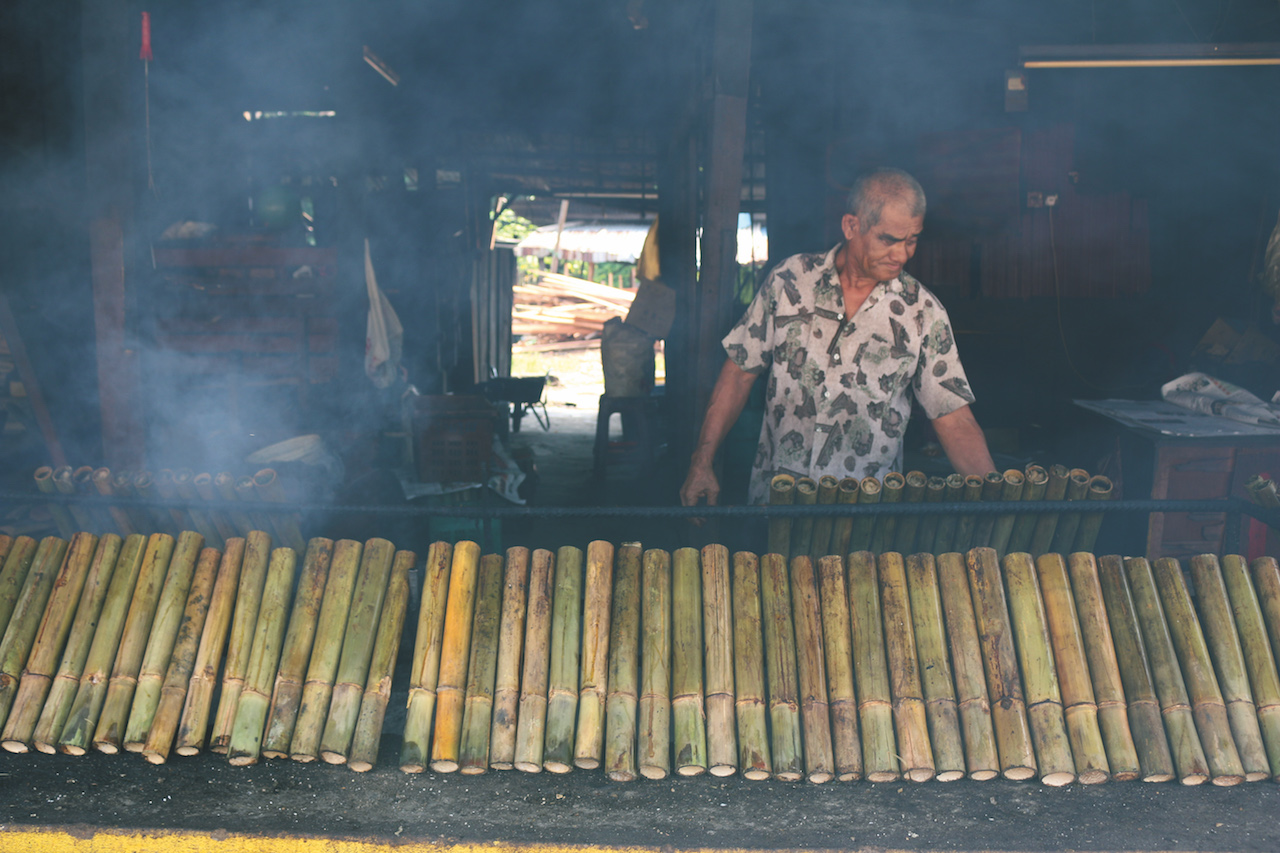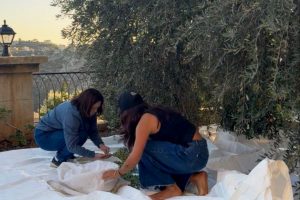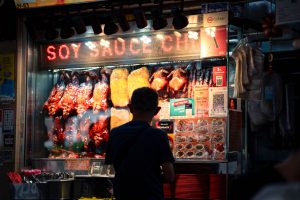As far as Lee Tiong and the other residents of Kampung Tendong are concerned, their neighbourhood is one sprawling kitchen garden. Guided down dirt roads and past bungalows swallowed by feral foliage, Kun and I have our attention directed to lush bushes of ulam raja, their yellow blossoms like fizzy sunbursts. Following this, shrubs lit with bullet chillies jade and vermillion; several fruit-bearing trees, from midnight horror and wild cherry to bilimbi and katak puru.
Buah katak puru means “toad fruit”, a title derived from its knobbly, matte green skin. That it is mostly spotted cluttering trunks rather than dangling off branches makes the similarity even more uncanny.
Known also by its scientific name, Cynometra cauliflora, it is never cooked. Instead, its crisp, astringent flesh with nothing save a pinch of salt is loved by elderly folk, a fondness that young people find inconceivable.
Lee Tiong, whom close friends call “Ah Chai”, is Hokkien, belonging to the majority of the Chinese population in Kelantan. Although not much is known about their earliest forebears, we know from Hai Lu Chu, or “A Record of the Seas”, the work of Hsieh Ching-kao, that Chinese settlements in the state achieved stability by the late 18th century. There were two groups of Chinese settlers at the time: the Hokkiens and Hakkas.
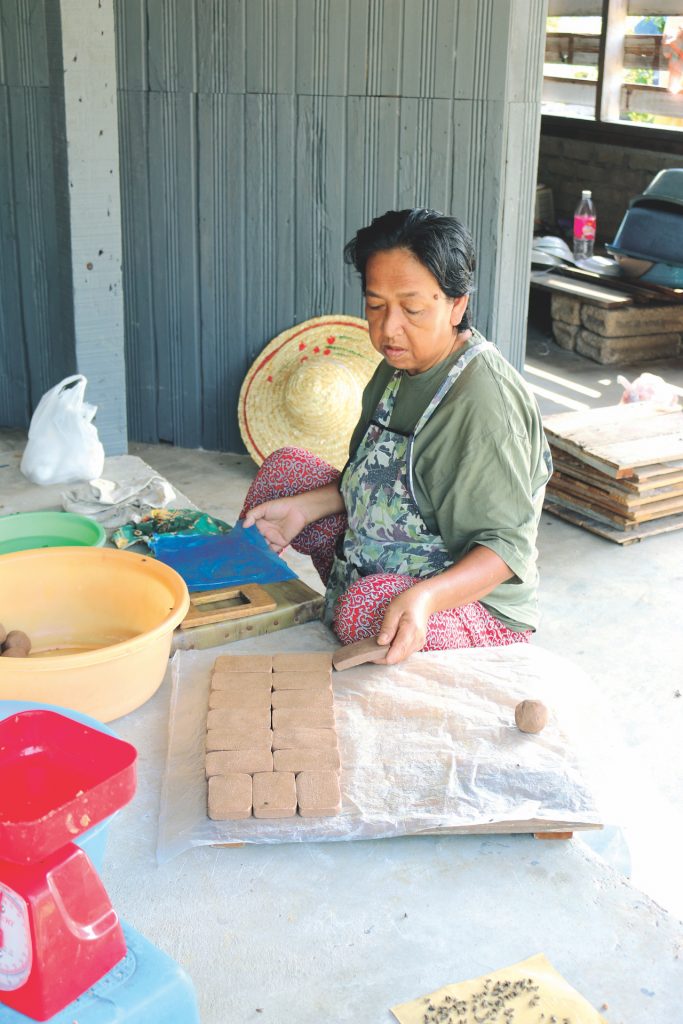
The Hokkiens lived in settlements spread across the entire state, with the traders living in urban and semi-urban areas while the farmers settled in rural areas, together with Malays and ethnic Thais. The Hakkas, in contrast, led an isolated existence, working in the gold mines in the lush forested interiors of South Kelantan.
The Chinese residing in villages in the countryside are called Kampung Cina; those in towns Bandar Cina. The present-day Kampung Cina, all of whom are Hokkien, go by another title: Kelantan Peranakan Chinese. It was in the interest of their ancestors to adapt to the predominantly Malay environment by learning the vernacular, practising local customs, wearing local clothes, eating local food, and engaging in local pastimes. Most of these Hokkien men had no interest to marry but the few who did likely wed into Thai families; Malay families forbade their women from marrying men who were not of the Islamic faith.
Such unions marked the beginning of the Kelantan Peranakan Chinese. Their offspring were raised Thai, taught the Thai language, and educated about Thai culture, only assimilating into their Malay surroundings at a later age. In the late 17th century, these Kelantan Peranakan Chinese were joined by a good number of Patani Peranakan Chinese who were escaping harsh Thai rule.
The Bandar Cina comprise various Chinese dialect groups, with Hokkiens in predominance. Unlike the Kampung Cina, their assimilation into the Malay environment was rather limited. The general absence of Malays in towns spelled little need for cultural adjustment on the part of early Hokkien traders, who later found themselves outnumbered by, and subsumed into, the inhomogeneous influxes of Chinese immigrants between the mid-19th to 20th centuries.
The evolution of the Kelantan Peranakan Chinese community can be seen in their eating habits and food. While Lee Tiong takes a cleaver to a large, tiger-striped watermelon, Kun and I sit at a raw wooden table in his family’s backyard, in the company of his mother. She shares with me, through Kun and her son, her knowledge of the food in these Peranakan Chinese households.

The first to roll off her tongue is kiam chai tng, a soupy braise of salted mustard greens and pig trotters. The recipe for this is standard, with hardly any deviation from the original Hokkien template, where onions, garlic, soy, chilli and tomatoes form the foundation of flavour. Next is ba hong, sweet-braised pork belly with soy, cinnamon and star anise, which was localised through the use of gula melaka (coconut sugar). These two dishes are commonly served at Kelantan Chinese wedding banquets.
The Kelantanese Peranakan Chinese have a fondness for Malay dishes. Curries are often laced with chilli and tamarind; asam pedas, an especially sour, spicy number, brings particular joy. Lee Tiong himself finds comfort in a simple meal of rice, ulam and budu, which the East Coast Peranakans simply love; splashes of the pungent, greyish liquid are consistently found in Peranakan curries and meat-based kerabu. They hold belacan in similarly high esteem, and revel in the fetid astringency of tempoyak—fermented durian—sometimes swirling spoonfuls into singgang.
The Terengganu Peranakan Chinese were born from assimilation rather than intermarriages. (As mentioned, Malays formed the majority and, being Muslim, were opposed to such unions; the only other ethnic group was a small Thai community in Besut, near the Kelantan border.) It has been suggested, however, that a small number of marriages between Chinese settlers and Malays may have occurred before the arrival of Islam, or perhaps during its nascency.
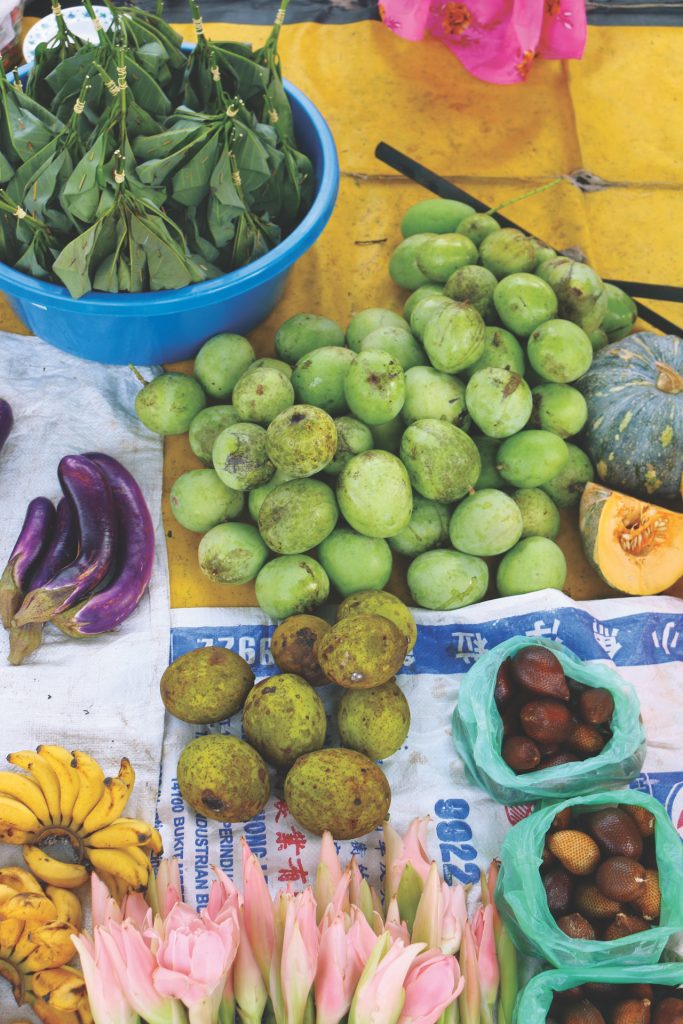
As with Kelantan, the Hokkiens form the Chinese majority in Terengganu. Their forebears were sailors and fishermen, and adapted to the ways of the bumiputera. Those who settled in Kampung Tirok fused their dialect with Malay to create a patois unique to the area. The other settlers were Hainanese, who worked in rubber plantations and restaurants—Hakka in the construction and quarry businesses; Cantonese in precious metals; Teochew in the grocery trade. In the mid-1900s, a tiny number of Yunnanese businessmen and traders arrived in Terengganu before dispersing into other states after several decades.
My maiden voyage into the world of Terengganu Peranakan Chinese cuisine happened on an especially searing May afternoon, at Madame Bee’s in Kuala Terengganu, with national artist Chan Fee Ming, over glasses of calamansi juice and a plate of rojak ceranang. To make this dish, cucumber and jicama matchsticks, water convolvulus, and keropok lekor are draped in a thick, mildly spiced, peanut sauce.
As we ate, he talked a bit about another rojak in Terengganu, one of pale orange papaya shreds and pineapple slices, moistened with a tangy, chilli-laced dressing thickened with pounded grilled fish. Its name is rojak betik (betik means “papaya”) or gonyok. He enlightened me about the local kicap manis, which I had confused with the Indonesian sweet soy sauce. A heady brew, it is made by simmering budu with coconut sugar, lime leaves, galangal, coriander, lemongrass and, sometimes, sesame seeds. It is the go-to condiment for keropok lekor or ngoh hiang, “sausages” of pork, prawn, spring onions and water chestnuts, seasoned with five-spice powde; its name means “five scents” in Hokkien. The sausages are then swaddled in beancurd skin and fried to a crinkly, bronzed turn.
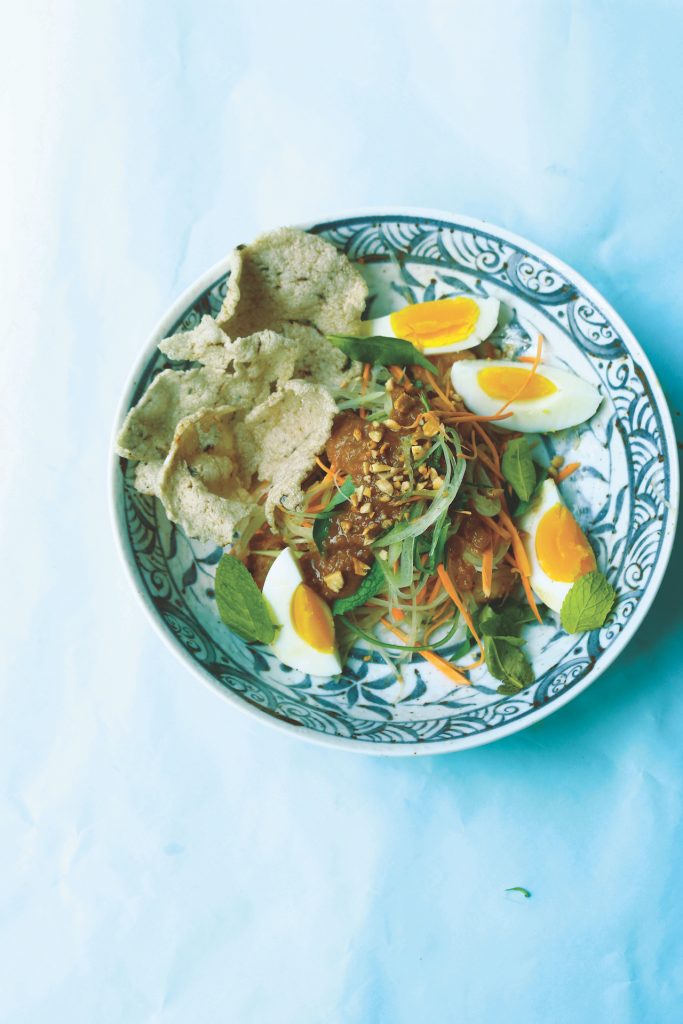
I had the chance to return to Terengganu several months later. Over a laksa lunch with researcher and conservationist Alex Lee, who runs the Terradala Museum Café and Terrapuri resort, I got to learn about the local ba chang, a tubby banana leaf cylinder of glutinous rice filled with spiced minced chicken and green mung beans, quite different to the pyramidal dumplings I had been eating all my life. Especial mention was also made of hu kun thng, the Peranakan singgang, sweetened and dimmed with coconut sugar; kay choo budu, braised chicken with budu; ayam golek, chicken basted in a spicy, coconutty gravy during its sojourn on the spit; and pulut lepa, grilled glutinous rice parcels with a beam of sambal running through them. The Chinese also add ginger to this filling of sambal.
As Alex and I rounded off our meal with mohor—steamed sweet potato sponges, and bowls of pengat jagung, shaved corn cooked in coconut milk—I learned that Alex’s mother, who resides in Marang, is an incredible cook and that one of her specialities is kerabu laksa, rice noodles seasoned with budu (naturally), and completed with a frisson of chopped torch ginger, holy basil, and Vietnamese and regular mint.
Later that year, I had the good fortune of meeting Terengganuan retail consultant Tino Soon in Kuala Lumpur. Up till then, our schedules had always been in conflict. Over tea, he brought up dishes from his childhood that had become elusive, in particular genang bawang, sambal-stuffed onions; chai tau kueh, a steamed cake of ground rice, water and, interestingly, semi-ripe papaya, in place of the usual white radish.
He also spoke about the roles food played in local ceremonies and festivals. Mee sua bakwan tng, a meatball soup with fine wheat noodles, is considered standard birthday fare. The noodles symbolise longevity, the meatballs and accompanying hardboiled eggs prosperity. A pair of seng lay, boiled ducks or chickens, are used with other dishes as offerings during ancestral worship. After the prayers, the birds are usually taken home, shredded, and made into kay char yiam, chicken with garlic and salt, or kay hong, the poultry equivalent of ba hong.
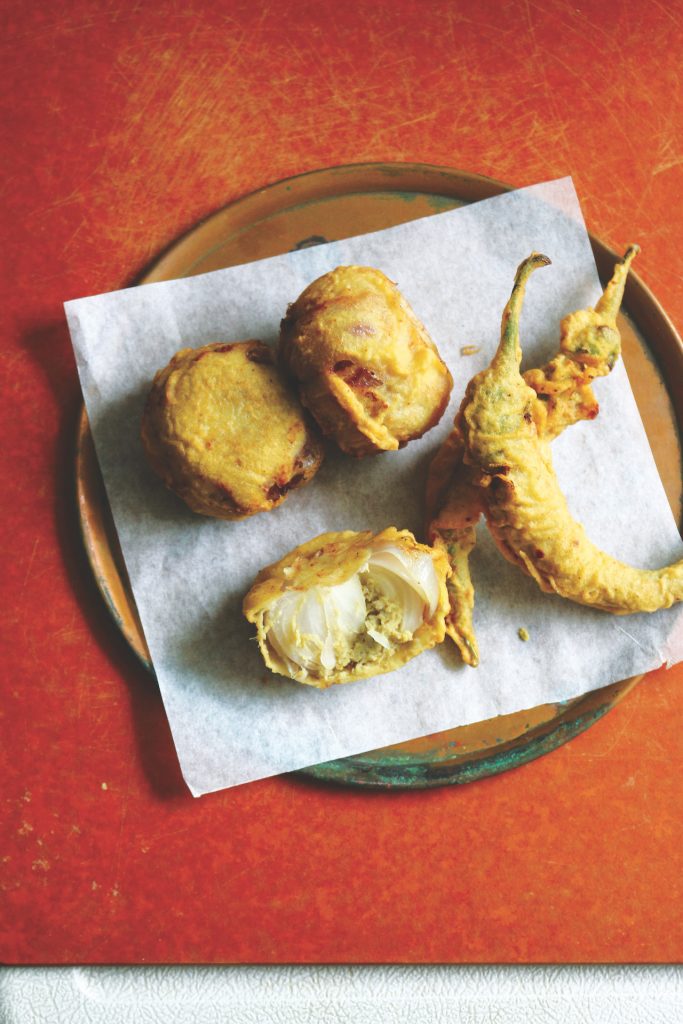
Every Lunar New Year, biscuits, snacks and sweetmeats would emerge in mind-boggling variety. They would contain sugar to represent sweetness, sesame and pumpkin seeds to represent fecundity, and even wear shades of gold, red or yellow wherever possible to represent auspiciousness. Such treats include clove-pierced pineapple tarts; kuih kapit, embroidered scrolls of coconut wafers, also called “love letters”; kuih bangkit, melt-in-the-mouth arrowroot biscuits; kuih wahulu, like airy, spongier madeleines; and nian gao, a confection made by cooking and stirring ground glutinous rice and brown sugar over the tamest heat for as long as twelve hours, the resultant stickiness meant to symbolise and promote unity. This delicacy, sold in squat, portly cylinders lined with banana leaf, can be eaten steamed, in gooey spoonfuls, or sliced and fried in a little oil.
Nasi kunyit, glutinous rice cooked with turmeric, has a role in a newborn’s first full moon in East Coast Peranakan Chinese households.
If the child is female, it will be served with inti kelapa, grated coconut cooked with sugar. If it is male, it will be served with salted duck eggs and fish, prawns fried with tamarind, and kutuk, called kerutuk in Kelantan, a chicken or beef curry enriched with toasted coconut.
Have something to say about this story or anything else? Write to us at community@ricemedia.co.

